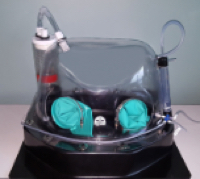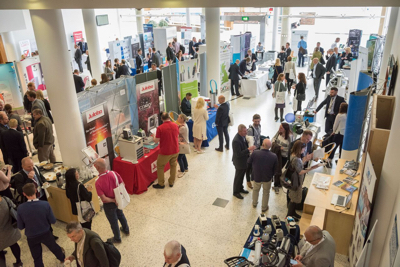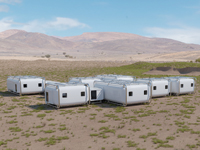This conference was organised by the not-for-profit initiative S-Lab, which works with universities, research institutes and other laboratory sectors to support good practice in lab design, operation and management. This year it was run in conjunction with a meeting of the International Association of Science Parks and Areas of Innovation (IASP) and UK Science Park Association (UKSPA). It provided an opportunity for those working in science facilities large and small to learn about building design trends and reducing facility operating costs. More than 60 presentations covered everything from designing collaborative research spaces to refurbing labs and vivariums to help cut energy use and improve safety.
An interesting keynote was delivered by Dr David Canter, Senior Associate VP, University of Michigan and Executive Director, North Campus Research Complex; In 2009, Michigan University bought a large campus from pharma giant Pfizer and Carter gave an insight into how the University went about developing the site. It had a large drug production facility, research labs as well as some 90 acres of vacant land.
Many other large facility design projects were covered throughout the two-day programme, some of which were winners in the S-Lab Awards (see panel below).
Other presentations covered noteworthy developments and initiatives on a much smaller scale. For example, Steve Tattershall (Banthrax Corp), gave a presentation on “Streamlining isolation” that looked at how laboratories are moving away from static cleanrooms to less complex containment options.
Banthrax’s Posi-Dome I-Box supports this streamlining of isolation, said Tattershall. Its simple, rugged design is said to deliver isolation for aseptic, hypoxic or other special atmosphere work when conditions mean that traditional glove box and laminar bench units would not be practical, such as in the field.

The Posi-Dome I-Box from Banthrax
Made of special UVC polymers and weighing less than 7 kilos, the 24 x 24in (61 x 6lcm) polymer bubble isolator provides an inert controlled atmosphere. It requires only 3W solar power or a car battery to run and operates at 38°F/3.3°C. with negative pressure and can include pass-throughs for fluid connections. It also caters for three cables to be connected to sensory devices. Approved in Canada, it is now being marketed in the EU and has already been used by universities for research in the field.
Leaner labs
Room ventilation in research facilities is a frequent topic at this event. Whether cleanrooms, wet labs with fume cupboards or vivariums, the need to remove contaminated air is a major user of energy for both commercial and academic research organisations. Some estimates put HVAC use alone at around 60–80% of total lab energy use.
A more recent approach to lab ventilation was presented by Gordon Sharp, COO at Aircuity. He said that although labs often handle toxic chemicals, studies show that, on average, lab air is clean more than 98% time, particularly at night and weekends when the labs are not in use. Yet current air change rates are based on an assumption that the air is contaminated all of the time.
He discussed the concept of demand-based control which directs air samples from individual fume cupboards to its multiplexed sensing technology to detect undesirable compounds and gases – when detected the system ramps up the air changes. Sharp argues that demand-based control can reduce air change rates down to two air changes per hour (2ACH).
He said that fixed ACH values are gradually being dropped in US guidance. He cited NFPA 45: The US Standard on Fire Protection for Laboratories Using Chemicals, as well as Chapter 16 of the ASHRAE Handbook for Laboratories (2011) which now recommends active/ demand based control.
Sharp gave many case studies where, using Aircuity’s demand-based control system, HVAC energy consumption had been reduced with large savings.
Sensing contaminants
Safer ventilation control for laboratory containment devices using measured containment control (MCC) was the topic of a presentation by Roy Allwood (Labway Services) and Mark Dawes (Halton UK).
In recent years Variable Air Volume (VAV) fume cupboards have gradually replaced the more traditional fixed air volume cupboards. The basis of the MCC proposal is that Variable Air Volume (VAV) control can be more effectively achieved by means of direct measurement of contaminants within the fume cupboards, improving both safety and energy efficiency.
MCC typically uses VAV-modulating dampers that are controlled by signals from contaminant and/or condition sensors (e.g. volatile compound or particulate) in the exhaust duct connection with optional readings from within the fume cupboard itself.
The prototypes for this type of solution are currently under development at Halton’s innovation lab in Finland. The speakers said the response of the sensor to the presence of chemicals is virtually instantaneous; and that the overall time taken to open the VAV damper to Vmax and rebalance the system at the minimum matches the response time of a conventional VAV system (3-4 secs).
Studies carried out so far have concluded that VOC sensors can be used in fume cupboards with a high degree of certainty of detecting contamination and that the optimum location for the sensors is in the extract duct or beside the duct. The developers say that MCC will respond to a contaminant release even when the area is unoccupied and that night set-back volume control is not necessary. In addition, where conventional VAV systems depend on the sash being closed to optimise energy efficiency, MCC does not.
The prototype is now undergoing field trials in a university for “in-use” conditions. Use data is being collected to calculate specific ppm “trigger points” to allow sensors to be programmed for specific levels. The set points may vary for customers and applications.

The two-day event included an exhibition of lab suppliers, facility designers and construction firms
Improving vivarium design
Vivariums used for animal tests are typically high users of energy with some 60% of carbon emissions coming from fans and pumps. Dr Lesley Penny, University of Edinburgh and Ben Breaden, BuroHappold, described an ongoing project at the University of Edinburgh to optimise HVAC use in its in-vivo facilities. The project reflects changing attitudes from the UK Home Office (HO) and the need to improve the quality of science – something that can only be achieved through ensuring the test animals used are healthy. For example, issues, such as whether cages at the top of the room are hotter than those at the bottom could affect research results, have prompted companies to relook at vivarium design.
Other drivers for change are: the welfare of vivarium staff; the unpleasant working conditions in rooms with no windows and the need to minimise running costs. It is also desirable to limit entry and minimise maintenance, so as not to disturb the animals. A further trend is the need for flexible buildings for future changes in the code of practice.
For many years, 15–20 ACH have been recommended in vivariums to provide fresh air for respiration, deal with room heat gains, dilute gas and particulate contaminants, adjust moisture content and maintain cage design temperature.
The speakers said the situation had recently changed and temperature and humidity need to be better adapted to what the specific animal species need.
The HO guidelines for housing animals for research purposes is covered under Section 2, Environmental conditions. Section 2.1 on Ventilation and Temperature states: “Insulation heating and ventilation of the holding room shall ensure that the air circulation, dust levels and gas concentrations are kept within limits that are not harmful to the animals housed, and are appropriate for the housing system in operation.”
“Temperature and relative humidity in the holding rooms shall be adapted to the species and age groups.”
In Chapter 3 (advice) Section 2.1 Engineering standards, performance and welfare, it states: “...The intention of providing these ranges is to indicate typical values that will normally satisfy the requirements of Sections 1 and 2 to provide ‘appropriate’ environmental conditions.
However whether the environmental conditions are or are not appropriate will ultimately be assessed by performance and welfare outcomes.”
Section 3.1 allows some flexibility in design of the vivarium but to be acceptable to the HO, designers need to prove that it works.
Penny and Breaden explained how providing sealed cages, each with its own air supply and removal, provided a more constant temperature in all cages, top and bottom. It is easier to control for those working in the lab and helps to reduce allergies among workers. The air flow required to keep the cages appropriately ventilated requires less energy compared with keeping the whole room ventilated. The HVAC equipment is preferably placed outside the lab to reduce noise and vibration which could upset the animals.
Upgrading fume cupboards to VAV
Dan Fernbank, Energy & Sustainability Manager, University of Reading, presented a fume cupboard upgrade project that saved the University of Reading £315,00 per anum with a three year payback.
The University has 252 fume cupboards and most of these were constant velocity fume cupboards making the lab cold and drafty. The project converted 145 cupboards across 22 labs and three buildings to VAV with new controllers. VAV modulates volume of air pulled through the fume cupboard dependent on sash height and saves energy by extracting less conditioned air, which means there is lower heat loss. Meanwhile, supply is modulated to match fume extract, thus using less electrical motor energy.
The project was described in detail and Fernbank said communication was key to getting the right support. This meant many meetings with heads of departments and the UK Health & Safety Executive. In addition to the energy savings of £208,430, the University also saved £108,250 on gas heating and the labs were much quieter and more comfortable.
For more information about more initiatives for effective energy use in labs and announcements about future S-Lab events visit: www.effectivelab.org.uk

AIT’s lightweight, easily transportable, self-contained modules can be quickly set up in the field as labs
Winners of the 2017 S-Lab Awards
Winner in the Life Sciences Research Building category
The Cardiff University Brain Research Imaging Centre (IBI)
This £44m, 6,639m² BREEAM Excellent building brings together expertise in brain mapping with the very latest in brain imaging and brain stimulation technology to better understand the causes of neurological and psychiatric conditions. It houses a combination of neuroimaging equipment unique within Europe and is one of only two worldwide with access to microstructure MRI facilities. The design enables collaborative research and attracts research and technical staff from around the world.
Winner in the Translational Research Building category
University of British Columbia’s Djavad Mowafaghian Centre for Brain Health (Stantec)
This £25m, 13,000m2 building houses a new institute, uniting both patient clinics and research as well as bringing together all the disciplines involved in brain health such as neuroscience, neurology and psychiatry. The centre exemplifies a new trend in medicine that blends the art of caring with the science of curing. This new facility harnesses the best of these aspirations into a singular translational research environment – agile theme-based research units are supported by advanced imaging facilities all connected by a network of “collision zones” to promote collaboration and innovation.
Winner in the Refurbished Laboratories category
High Performance Rebirth for Interdisciplinary Research at Cornell’s Kimball Hall (Payette)
The renovation of Cornell University Kimball Hall was a prototype project to demonstrate the potential existing buildings have to meet the next generation of interdisciplinary research needs. It weaves together a series of layers (low energy office workspace, high intensity support zone and a highly flexible open research laboratory) to create an integrated and cohesive research neighbourhood.
Winner in the Physical Sciences Building category
The GlaxoSmithKline Carbon-Neutral Laboratory for Sustainable Chemistry, University of Nottingham (Fairhurst)
The UK’s first net zero-carbon building, achieved through natural materials also has high energy efficiency. All energy is provided by renewable sources (such as solar power and sustainable biofuel) and excess energy is used to heat a nearby offices and provide carbon credits over 25 years to cover all embedded carbon.
Winner of the Sustainable Science Building S-Lab/UKSPA Award
The University of Leicester’s Centre for Medicine Building is Passivhaus Certified (Willmott Dixon)
This £42m, 12,836m2 project provides teaching facilities, offices, labs, lecture theatres and support spaces for over 2,350 staff and students from the Schools of Medicine and Psychology and the Department of Health Sciences. Leicester Medical School has revised its undergraduate curriculum to take full advantage of the opportunities offered by the building, stressing real-world experience and scientific understanding. It has a BREEAM Excellent and EPC A rating and is the UK’s largest non-residential building constructed to Passivhaus standard, with an energy consumption of just 80kWh/m2 compared to 500kWh/m2 in the facilities that it replaced.
Winner in the Laboratory Effectiveness category
A Free Platform for Science Resource Sharing: Open IRIS at the Friedrich Miescher Institute
Open IRIS is a free non-commercial platform to enable research resource discovery and sharing for researchers within and across labs and organisations. It is also a collection of tools and best practices for resource management and optimisation, as well as facilitating collaboration and resource sharing.
Winner in the Laboratory Environmental Improvement category
Fume Cupboard Upgrades at the University of Reading: Save £315,000 pa, with a 3 Year Payback
A £1m upgrade programme that included re-balancing of face velocities across the 252 fume cupboards on campus, which were running on average 19% above the University’s minimum standard, and upgrading 145 fume cupboards to VAV with the associated installation of new controllers. Some 98 extract fans have been replaced with high efficiency equivalents that cut energy use by an average of 32%. Ventilation to 49 chemical storage cupboards has been re-ducted to reduce air flow and enable the fume cupboards to be switched off when not in use.
Winner of Best New or Improved Product
TRUEscience pH meter (Camlab)
This new range of pH meters from TRUEscience combines all the functions of a highly specified pH meter with functions such as logging, alarms and data sharing in an affordable package.
Winner for Best New Laboratory Concept
Shellbe – a Modular and Portable Cleanroom System Enables Rapid and Low Cost Deployment (Adriatic Institute of Technology)
Shellbe is a modular, scalable, movable and reusable self-contained housing system that could improve the medical care in remote parts of the world. Easily shipped, assembled and moved, it is autonomous for water and energy supplies and waste materials management. The basic module, made by assembling a minimal number of components, could be a cleanroom, operation theater, medical clinic, pharmacy, lab or research station. It complies with standards of sterility, air and particulate control normally only available in (better) stationary buildings, such as in technical and aseptic cleanroom facilities.
Winner of the Making a Difference category
Erin Fry, University of Chicago for A Bottom-up Green Lab Improvement Initiative
Until 2015, the University of Chicago had no programme or guidelines to decrease the impact of its scientific research on the environment: Human Genetics doctoral student Erin Fry wanted more to be done so she founded UChicago GreenLabs on her own initiative. Fry worked with scientists and fellow students to drive a “bottom up” initiative that has certified 12 labs, and implemented sustainability initiatives in several departments. Fry’s achievements offer inspiration learning on what can be done without institutional support and how to successfully engage with lab users.




